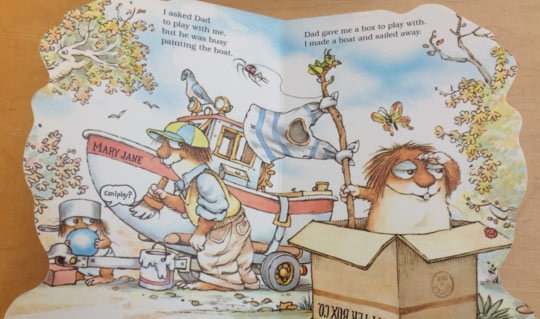Why Isn’t My Child Talking?

All children develop differently. Some kids talk early with first words around 10 months and some kids start talking a bit later with first words around 14 months. If your child is a late talker there are things you can do at home to help.
What can you do to encourage her to use verbal language to communicate more?
Most parents gut reaction is to ask questions – lots and lots of questions.
I will use a book reading as an example (pictured above), but this can carry over into every activity: meal-time; bath-time; play-time.
- “What is Little Critter sitting in?”
- “Where is the blue bird?”
- “What is daddy doing?”
- “Who has the blue ball?”
If this is you, fear not. You are not alone. Many parents communicate with their children this way. They ask questions to elicit a verbal response from their child.
But, let’s put this all into perspective
When the question is posed, your child probably feels like she is on-the-spot and likely feels a lot of pressure to perform. Now think about whether a high pressure situation gets easier or harder when you are inundated with questions. Many of which, you may not know the answer to.
Let’s think about this fantastic communication opportunity in a different way. How can you enhance language without putting pressure on your child to perform?
Let’s take the same book and this time, eliminate all questions. So, how would this sound?
“Little Critter is in a box.”
3-5 second pause
“Blue bird is on the boat!”
3-5 second pause
“Daddy paints the boat!”
3-5 second pause
“Sister has the blue ball!”
5 second pause, let your child turn the page
Ok, now let’s break it down
- Shorten your sentences: “Bird on boat” is ok too but my preference is always to keep the grammar intact. Keep it as short as you can without losing meaning or grammar.
- Be a model for your child: If you want your child to be able to say “Sister has the blue ball” you have to teach her to say that. For children who are language delayed, asking “where is the ball?” is likely to get a finger point rather than a verbal response. If you model the language, it is more likely that after reading this book a few times and using similar phrases each time, your child will begin to use the modeled language.
- Give them time: Allow your child a few seconds to process what you’ve said before moving on. A 3-5 second pause will seem like an eternity when you begin this new way of communicating but do your best to count silently to at least 3 in order to give your child sufficient time to process and respond if she chooses.
- Let your child lead: If she doesn’t want to sit through you telling her 4 things on each page, don’t force her to stay on that page. Move on with her and try to stay at her level.
There you go! A few tips on how to elicit verbal language in a child who’s not talking as much as they should.
Please feel free to comment or ask questions below. Don’t forget to share our blog if you find it helpful, funny, or interesting.
About the Author

Kerisha has been inspired since an early age to work with children with special needs. She volunteered with the United Cerebral Palsy Center as a teenager and knew she wanted to work with children with special needs. When a friend of hers told her about a University of San Diego degree in speech-language and hearing sciences, Kerisha knew she had found her calling.
Kerisha enjoys working with children with a wide variety of challenges and her ability to connect with them is crucial in helping them unlock their full potential. She enjoys the one-on-one relationships she has with her clients as she watches them grow into confident young men and women.
It's rare to find anyone who loves their job as much as Kerisha and this dedication is appreciated by both colleagues and clients.